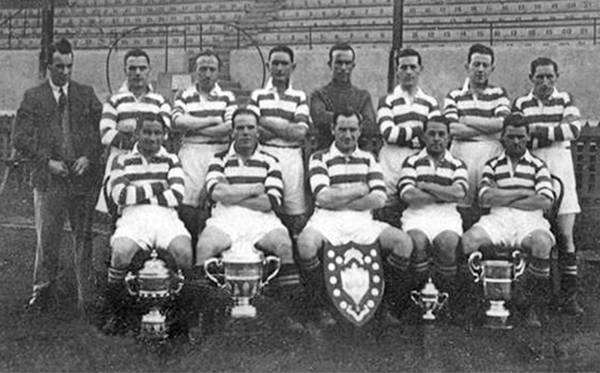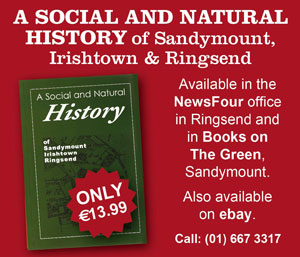
Pictured: The 1935-36 Shamrock Rovers Team pictured at Milltown. Babby Byrne is the player standing at back and far left.
David ‘Babby’ Byrne was born in 1905 in Ringsend and lived in Thorncastle Street with his parents and ten siblings. He was known as Babby because he was the youngest of 11 children, not because he was small. From a young age, Babby showed talent as a footballer.
He was five foot five in an era of very tall strikers but that didn’t bother him. He was a powerful force in attack and known as a scourge to goalkeepers.
He constantly harried them and forced them into mistakes; his speciality was stealing the ball as the opposition keeper bounced it on the ground. It must have been great fun to see him buzzing around, tricking the goalies out of the ball, and then planting it in the net for a goal.
His first season with Shamrock Rovers in 1926/27 was perfect for him and his team, as they went undefeated in winning their third League of Ireland title, and Babby was league top scorer. His record of 17 goals in 18 games brought him a transfer to England, where he joined Bradford City for the next season.
This spell in Yorkshire didn’t work out. His new club was a third division outfit and he made only three appearances for them and scored just one goal before returning home.
He came back to Dublin, back to Ringsend, and signed for his local club, the mighty Shelbourne. It was a good move. They won the championship, with Babby’s goal tally again in double figures. He then won his first international cap, and scored in his debut against Belgium. Winning the title and banging in the goals was not enough to hold him with the Reds, though, and he transferred back to Shamrock Rovers for the start of the 1929/30 season.
This was when he reached the summit of his career, a period of great success for himself and his club. He was the club’s top scorer for the next two seasons, and Rovers began to establish their reputation as FAI Cup specialists.
The 1930 FAI Cup Final between Brideville and Shamrock Rovers was perhaps the match he is best known for.
The Irish Independent told how Brideville were on top during the first 15 minutes and had one good chance before Rovers “replied strongly”. But their goalkeeper “baulked Byrne from eight yards out”. Brideville rallied again, missing a tap-in before half time.
In the second half, it was more of the same. Brideville attacked, Rovers replied and Babby missed good chances. He was “neatly placed” by Sloan but missed out. Next, he chased down a long clearance from his defence, but was just beaten to the ball by the Brideville goalie. Twice more Babby was foiled as the keeper saved, first a header, then a shot “which looked like a certain score”.
Again, Rovers pushed back and, again, Babby couldn’t score. Another chance came and went when he was put through on goal but shot wide. Watching the ball miss the target, Babby must have felt it wasn’t his day. When Rovers suffered a disallowed goal, and then an offside flag on Golding when he was clean through, Babby must have thought his missed chances were going to cost his team the cup.
Then, in the dying seconds of the match as the crowd rose and prepared to leave the ground, that other local hero Bob Fullam got hold of the ball and crossed it high and hard into the area. The Brideville defenders, tired but determined to hang on to the draw, cleared it. Fullam got it again, and crossed it again. This time, it reached a Rover, Sloan, who headed it at goal. Then Babby Byrne jumped. There was that silence for a moment, then the roar. The ball was in the net.
That was the 1930 FAI Cup final and the goal Babby scored turned out to be the winner.
The Independent described the goal in a matter-of-fact way, but perhaps with a shade of gray between the lines:
“Byrne jumped to glance it with a neat header into the corner of the net.”
It made no reference to any cheating or foul play for the winning goal.
However, that goal is said to have been the first “verifiable” Cup final handball decider. In the official history of the FAI Cup, Babby spoke of this dubious honour: “A very high ball was floated across and I got in between Charlie Reid, who had dropped back to defend, and the goalie Charlie O’Callaghan. I jumped up, my hand hit the ball first and it went in.”
He went on to say that he “got into trouble” scoring the goal, not because of the handball but “because a draw seemed on the cards and that would have meant more money.”
Dubious or not, the goal stood and it was Babby’s sixth in the cup that year, and earned him his first Cup winners’ medal. He had worked hard and shown his fierce determination that day. He kept missing, but kept going back for more.
He went on to win another three FAI Cups in that second spell with Rovers. Along with two League of Ireland Shields, three Leinster Senior Cups and a League of Ireland title.
Babby’s high standard of performance in those years earned him another transfer to England, and he joined Sheffield United for the 1932/33 season. Again, it was not a positive move for Babby. At that time, his fellow Ringsender Jimmy “Snowy” Dunne was at the height of his career as an ace goalscorer for the Yorkshire club. Babby found it impossible to get a game, and headed for home again.
He was back at Shamrock Rovers, and had a below-average return, scoring just seven goals in the 1933/34 season. While he hadn’t had his greatest couple of years, his career record proved the old saying in football, and no temporary loss of form could hide the permanent class of Babby Byrne. So it was that, following that disappointing return to Rovers, Babby put on his wandering boots again.
Right after the Irish season ended in 1934, he made a pioneering journey, becoming the first League of Ireland player to sign for the mighty Manchester United. It couldn’t have started any better and he scored in his first game for the Red Devils. But reality would not refrain from crashing in on him, and it was to be another short stay in England.
Babby was almost thirty when his time in Manchester ended. He kept on playing, appearing for Glentoran and Larne in 1934/35. Over the next few years, he played for a different club each season, including a season each at Shamrock Rovers and his old foes Brideville. In 1939, after one last year with Shelbourne, he retired from football. He was a real Ringsender who played eight of his 13 seasons with either Shels or Rovers.
It was a long and exceptional career – for the small striker who made it big.
By Gavan Bergin



